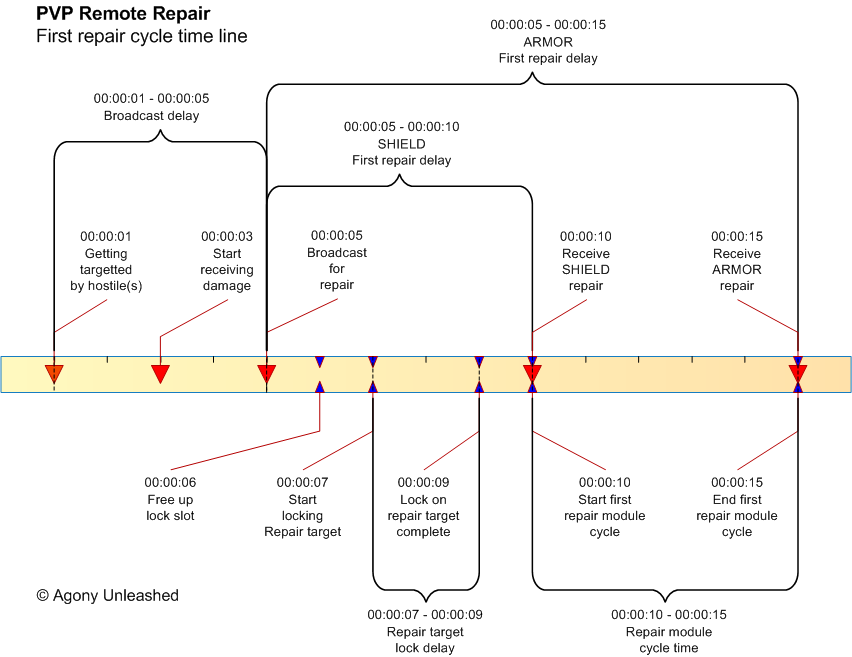Remote repair time line and cycle management
Contents
The remote repair time line
Understanding the time line for remote repairs deepens your understanding of the remote repair mechanic in all its aspects and allows you to separate the people who happen to fly a RR ship from those who master the mechanic.
There are really two phases to remote repair:
- First repair cycle
- Later repair cycles
Each phase has a number of specific characteristics and is important for a different reason.
First repair cycle time line
The first repair cycle is vital, because if a target is destroyed before a repair cycle is ever landed, remote repair will be completely defeated. The time line doe the first repair cycle should therefor starts much earlier then the actual remote repair module is started. The following image depicts this time line.

The image shows:
- the actions taken by the pilot of the ship requesting remote repair above the time line and with red triangles on the time line
- the actions taken by the pilot applying remote repair below the time line and with double blue triangles on the time line
- some important time spans
Let's go over the sequence of steps in the diagram.
- (Victim) Getting targeted by hostile (also called 'yellow boxed')
- (Victim) Receiving damage from hostile (also called 'red boxed'): Please note: this description is not 100% accurate. When being shot at by normal drones or missiles, you will get a 'red box' first and start receiving damage with a delay.
- (Victim) Broadcasting for repairs: The timing of broadcasting depends both on the broadcast strategy and human delay.
- (Repper) Frees up a lock slot (optional): During a prolonged battle or when flooded by broadcasts, a pilot might have to unlock a current target to be able to target, adding a human delay.
- (Repper) Starts locking victim
- (Repper) Has lock on victim: This is not an actual 'action', but more an event that a pilot has to wait for.
- (Repper) Starts first repair module cycle
- (Victim) ONLY SHIELD: first repair cycle lands
- (Repper) First repair module cycle ends
- (Victim) ONLY ARMOR: first repair cycle lands
Please notice that the times mentioned in the time line are fictional and depend on a number of things, like:
- human response time
- ships, fittings and bonuses involved
- broadcast strategy
Broadcast strategy
Different types of fleets, ships, fits and tactics could require a different broadcast strategy. In general, it is good to broadcast early, sometimes even when you are just yellow boxed. However, broadcasting too early also risks overloading pilots of remote repair ships, sometimes with requests for repairs that won't actually be needed. Finding a good broadcasting strategy depends on your fleet configuration and that of the hostiles.
Remote repair delay
The remote repair delay is the time between when a pilot requests remote repair and when the first rep actually lands. It is important to try to work towards minimizing it, because the effectiveness of remote repair is fully dependent on being able to land that first rep cycle before a ship dies and ideally before it gets damaged beyond the repair buffer.
The biggest factor in remote repair delay is the type you choose, since remote shield transfers restore your shield at the start of the cycle, where remote armor repair only applies the repaired HP at the end of the cycle.
Lock delay
Lock delay is a delay that is a technical
Module cycle time
Later repair cycles and cycle management
Once the first repair module has been activated (so before it has landed a rep cycle in case of an armor module), the pilot doing remote repair must start managing his repair cycles. How he does this depends on quite a list of variables, which we will discuss in this section.